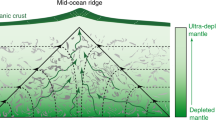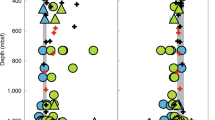Abstract
The Earth’s mantle beneath ocean ridges is widely thought to be depleted by previous melt extraction, but well homogenized by convective stirring. This inference of homogeneity has been complicated by the occurrence of portions enriched in incompatible elements. Here we show that some refractory abyssal peridotites from the ultraslow-spreading Gakkel ridge (Arctic Ocean) have very depleted 187Os/188Os ratios with model ages up to 2 billion years, implying the long-term preservation of refractory domains in the asthenospheric mantle rather than their erasure by mantle convection. The refractory domains would not be sampled by mid-ocean-ridge basalts because they contribute little to the genesis of magmas. We thus suggest that the upwelling mantle beneath mid-ocean ridges is highly heterogeneous, which makes it difficult to constrain its composition by mid-ocean-ridge basalts alone. Furthermore, the existence of ancient domains in oceanic mantle suggests that using osmium model ages to constrain the evolution of continental lithosphere should be approached with caution.
This is a preview of subscription content, access via your institution
Access options
Subscribe to this journal
Receive 51 print issues and online access
$199.00 per year
only $3.90 per issue
Buy this article
- Purchase on Springer Link
- Instant access to full article PDF
Prices may be subject to local taxes which are calculated during checkout





Similar content being viewed by others
References
Dupré, B. & Allègre, C. J. Pb–Sr isotope variation in Indian Ocean basalts and mixing phenomena. Nature 303, 142–146 (1983)
Hart, S. R. A large-scale isotope anomaly in Southern Hemisphere mantle. Nature 309, 753–757 (1984)
Zindler, A. & Hart, S. Chemical geodynamics. Annu. Rev. Earth Planet. Sci. 14, 493–571 (1986)
Hart, S. R., Hauri, E. H., Oschmann, L. A. & Whitehead, J. A. Mantle plumes and entrainment: isotope evidence. Science 256, 517–520 (1992)
Hofmann, A. W. Mantle geochemistry: The message from oceanic volcanism. Nature 385, 219–229 (1997)
Graham, D. W. in Noble Gases in Geochemistry and Cosmochemistry. Reviews in Mineralogy and Geochemistry Vol. 47 (eds Porcelli, D., Ballentine, C. J. & Wieler, R.) 247–317 (Geochemical Society and Mineralogical Society of America, Washington DC, 2002)
Salters, V. J. M. & Stracke, A. Composition of the depleted mantle. Geochem. Geophys. Geosyst. 5 10.1029/2003GC000597 (2004)
Workman, R. K. & Hart, S. R. Major and trace element composition of the depleted MORB mantle (DMM). Earth Planet. Sci. Lett. 231, 53–72 (2005)
Andres, M., Blichert-Toft, J. & Schilling, J.-G. Nature of the depleted upper mantle beneath the Atlantic: evidence from Hf isotopes in normal mid-ocean ridge basalts from 79° N to 55° S. Earth Planet. Sci. Lett. 225, 89–103 (2004)
Graham, D. W. et al. Cryptic striations in the upper mantle revealed by hafnium isotopes in southeast Indian ridge basalts. Nature 440, 199–202 (2006)
Brandon, A. D. et al. 190Pt–186Os and 187Re–187Os systematics of abyssal peridotites. Earth Planet. Sci. Lett. 177, 319–335 (2000)
Harvey, J. et al. Ancient melt extraction from the oceanic upper mantle revealed by Re–Os isotopes in abyssal peridotites from the Mid-Atlantic Ridge. Earth Planet. Sci. Lett. 244, 606–621 (2006)
Dick, H. J. B., Lin, J. & Schouten, H. An ultraslow-spreading class of ocean ridge. Nature 426, 405–412 (2003)
Michael, P. J. et al. Magmatic and amagmatic seafloor generation at the ultraslow-spreading Gakkel ridge, Arctic Ocean. Nature 423, 956–961 (2003)
Snow, J. Petrology Group ARK, XX-2. in The Expeditions ARKTIS-XX/1 and XX/2 of the Research Vessel “Polarstern” in 2004 (eds Budéus, G. & Lemke, P.) Rep. Polar Marine Res. 544, 153–208 (2007)
Shirey, S. B. & Walker, R. J. The Re–Os isotope system in cosmochemistry and high-temperature geochemistry. Annu. Rev. Earth Planet. Sci. 26, 423–500 (1998)
Parkinson, I. J., Hawkesworth, C. J. & Cohen, A. S. Ancient mantle in a modern arc: Osmium isotopes in Izu–Bonin–Mariana forearc peridotites. Science 281, 2011–2013 (1998)
Jokat, W. et al. Geophysical evidence for reduced melt production on the Arctic ultraslow Gakkel mid-ocean ridge. Nature 423, 962–965 (2003)
Goldstein, S. L. et al. Isotope geochemistry of Gakkel ridge basalts and origin of a ‘DUPAL’ signature. Ofioliti 31, 234 (2006)
Hellebrand, E., Snow, J. E., Dick, H. J. B. & Hofmann, A. W. Coupled major and trace elements as indicators of the extent of melting in mid-ocean-ridge peridotites. Nature 410, 677–681 (2001)
Hellebrand, E., Snow, J. E., Hoppe, P. & Hofmann, A. W. Garnet-field melting and late-stage refertilization in ‘residual’ abyssal peridotites from the Central Indian Ridge. J. Petrol. 43, 2305–2338 (2002)
Meisel, T., Walker, R. J. & Morgan, J. W. The osmium isotopic composition of the Earth's primitive upper mantle. Nature 383, 517–520 (1996)
Alard, O. et al. In situ Os isotopes in abyssal peridotites bridge the isotopic gap between MORBs and their source mantle. Nature 436, 1005–1008 (2005)
Reisberg, L. & Lorand, J. P. Longevity of sub-continental mantle lithosphere from osmium isotope systematics in orogenic peridotite massifs. Nature 376, 159–162 (1995)
Snow, J. E. & Schmidt, G. Proterozoic melting in the northern peridotite Massif, Zabargad Island: Os isotopic evidence. Terra Nova 11, 45–50 (1999)
Snow, J. E., Schmidt, G. & Rampone, E. Os isotopes and highly siderophile elements (HSE) in the Ligurian ophiolites, Italy. Earth Planet. Sci. Lett. 175, 119–132 (2000)
Pearson, D. G. et al. Re–Os isotope systematics and platinum group element fractionation during mantle melt extraction: a study of massif and xenolith peridotite suites. Chem. Geol. 208, 29–59 (2004)
Hassler, D. R. & Shimizu, N. Osmium isotopic evidence for ancient subcontinental lithospheric mantle beneath the Kerguelen Islands, southern Indian Ocean. Science 280, 418–421 (1998)
Seyler, M., Lorand, J. P., Toplis, M. J. & Godard, G. Asthenospheric metasomatism beneath the mid-ocean ridge: Evidence from depleted abyssal peridotites. Geology 32, 301–304 (2004)
Meisel, T., Walker, R. J., Irving, A. J. & Lorand, J. P. Osmium isotopic compositions of mantle xenoliths: A global perspective. Geochim. Cosmochim. Acta 65, 1311–1323 (2001)
Snow, J. E. & Reisberg, L. Os isotopic systematics of the MORB mantle: Results from altered abyssal peridotites. Earth Planet. Sci. Lett. 133, 411–421 (1995)
Standish, J. J. et al. Abyssal peridotite osmium isotopic compositions from Cr-spinel. Geochem. Geophys. Geosys. 3 10.1029/2001GC000161 (2002)
Escrig, S., Schiano, P., Schilling, J.-G. & Allègre, C. Rhenium–osmium isotope systematics in MORB from the Southern Mid-Atlantic Ridge (40°–50° S). Earth Planet. Sci. Lett. 235, 528–548 (2005)
Rehkämper, M. et al. Non-chondritic platinum-group element ratios in oceanic mantle lithosphere; petrogenetic signature of melt percolation? Earth Planet. Sci. Lett. 172, 65–81 (1999)
Walker, R. J., Prichard, H. M., Ishiwatari, A. & Pimentel, M. The osmium isotopic composition of convecting upper mantle deduced from ophiolite chromites. Geochim. Cosmochim. Acta 66, 329–345 (2002)
Hauri, E. H. Osmium isotopes and mantle convection. Phil. Trans. R. Soc. Lond. 360, 2371–2382 (2002)
Morgan, J. P. & Morgan, W. J. Two-stage melting and the geochemical evolution of the mantle: a recipe for mantle plum-pudding. Earth Planet. Sci. Lett. 170, 215–239 (1999)
Meibom, A. et al. Re–Os isotopic evidence for long-lived heterogeneity and equilibration processes in the Earth’s upper mantle. Nature 419, 705–708 (2002)
Walker, R. J. et al. 187Os–186Os systematics of Os–Ir–Ru alloy grains from southwestern Oregon. Earth Planet. Sci. Lett. 230, 211–226 (2005)
Frei, R. et al. Os isotope heterogeneity of the upper mantle: Evidence from the Mayari–Baracoa ophiolite belt in eastern Cuba. Earth Planet. Sci. Lett. 241, 466–476 (2006)
Pearson, D. G., Parman, S. W. & Nowell, G. M. A link between large mantle melting events and continent growth seen in osmium isotopes. Nature 449, 202–205 (2007)
Davies, G. F. Stirring geochemistry in mantle convection models with stiff plates and slabs. Geochim. Cosmochim. Acta 66, 3125–3142 (2002)
Wood, D. A. et al. Elemental and Sr isotope variations in basic lavas from Iceland and the surrounding ocean-floor: Nature of mantle source inhomogeneities. Contrib. Mineral. Petrol. 70, 319–339 (1979)
Le Roex, A. P., Dick, H. J. B. & Watkins, R. T. Petrogenesis of anomalous K-enriched MORB from the Southwest Indian Ridge: 11° 53′ E to 14° 38′ E. Contrib. Mineral. Petrol. 110, 253–268 (1992)
Hellebrand, E., Snow, J. E., Mostefaoui, S. & Hoppe, P. Trace element distribution between orthopyroxene and clinopyroxene in peridotites from the Gakkel ridge: a SIMS and NanoSIMS study. Contrib. Mineral. Petrol. 150, 486–504 (2005)
Büchl, A. et al. Melt percolation monitored by Os isotopes and HSE abundances: a case study from the mantle section of the Troodos Ophiolite. Earth Planet. Sci. Lett. 204, 385–402 (2002)
Anders, E. & Grevesse, N. Abundances of the elements: Meteoritic and solar. Geochim. Cosmochim. Acta 53, 197–214 (1989)
Johnson, K. T. M., Dick, H. J. B. & Shimizu, N. Melting in the oceanic upper mantle: an ion microprobe study of diopsides in abyssal peridotites. J. Geophys. Res. 95, 2661–2678 (1990)
Brunelli, D. et al. Discontinuous melt extraction and weak refertilization of mantle peridotites at the Vema lithospheric section (Mid-Atlantic ridge). J. Petrol. 47, 745–771 (2006)
Roy-Barman, M. & Allégre, C. J. 187Os/186Os ratios of mid-ocean ridge basalts and abyssal peridotites. Geochim. Cosmochim. Acta 58, 5043–5054 (1994)
Acknowledgements
We thank the Captain and crew of PFS Polarstern expedition ARK XX/2 and the other participants in the AMORE 2001 expedition. This work was supported by the Max-Planck Institute for Chemistry and the Deutsche Forschungsgemeinschaft to J.E.S. We thank N. Groschopf and D. Kuzmin for help with electron microprobe analyses, K. P. Jochum, B. Stoll and K. Herwig for help with laser ablation ICPMS measurements, K. Zentel for help with the Os-PGE experiment, and S. Shirey for comments on the manuscript. C.-Z.L. acknowledges scholarships from both Chinese Academy of Sciences and Max-Planck Society.
Author Contributions C.-Z.L. and G.B. did the Os-PGE measurements on samples collected by two Arctic expeditions proposed and carried out by J.E.S., together with E.H., A.v.d.H. and A.B., who also provided preliminary and supporting data. A.W.H. provided intellectual and material support. All authors contributed to interpretation of the results and writing of the manuscript.
Author information
Authors and Affiliations
Corresponding author
Supplementary information
Supplementary Table
The file contains Supplementary Table 1. (PDF 33 kb)
Rights and permissions
About this article
Cite this article
Liu, CZ., Snow, J., Hellebrand, E. et al. Ancient, highly heterogeneous mantle beneath Gakkel ridge, Arctic Ocean. Nature 452, 311–316 (2008). https://doi.org/10.1038/nature06688
Received:
Accepted:
Issue Date:
DOI: https://doi.org/10.1038/nature06688
This article is cited by
-
Heterogeneous mantle beneath the Neo-Tethys Ocean revealed by ultramafic rocks from the Xiugugabu Ophiolite in the Yarlung-Tsangpo Suture Zone, southwestern Tibet
Contributions to Mineralogy and Petrology (2023)
-
Compositional heterogeneity in the mantle transition zone
Nature Reviews Earth & Environment (2022)
-
Peridotites, chromitites and diamonds in ophiolites
Nature Reviews Earth & Environment (2021)
-
Competing effects of spreading rate, crystal fractionation and source variability on Fe isotope systematics in mid-ocean ridge lavas
Scientific Reports (2021)
-
What can we learn from REE abundances in clinopyroxene and orthopyroxene in residual mantle peridotites?
Contributions to Mineralogy and Petrology (2021)
Comments
By submitting a comment you agree to abide by our Terms and Community Guidelines. If you find something abusive or that does not comply with our terms or guidelines please flag it as inappropriate.



